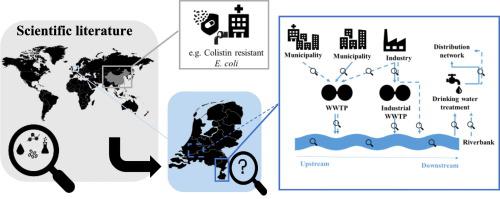Science of the Total Environment ( IF 8.2 ) Pub Date : 2020-06-26 , DOI: 10.1016/j.scitotenv.2020.140546 Julia Hartmann 1 , Inge van Driezum 2 , Dana Ohana 2 , Gretta Lynch 2 , Bjorn Berendsen 3 , Susanne Wuijts 4 , Jan Peter van der Hoek 5 , Ana Maria de Roda Husman 6

|
As well as known contaminants, surface waters also contain an unknown variety of chemical and microbial contaminants which can pose a risk to humans if surface water is used for the production of drinking water. To protect human health proactively, and in a cost-efficient way, water authorities and drinking water companies need early warning systems. This study aimed to (1) assess the effectiveness of screening the scientific literature to direct sampling campaigns for early warning purposes, and (2) detect new aquatic contaminants of concern to public health in the Netherlands. By screening the scientific literature, six example contaminants (3 chemical and 3 microbial) were selected as potential aquatic contaminants of concern to the quality of Dutch drinking water. Stakeholders from the Dutch water sector and various information sources were consulted to identify the potential sources of these contaminants. Based on these potential contamination sources, two sampling sequences were set up from contamination sources (municipal and industrial wastewater treatment plants), via surface water used for the production of drinking water to treated drinking water. The chemical contaminants, mycophenolic acid, tetrabutylphosphonium compounds and Hexafluoropropylene Oxide Trimer Acid, were detected in low concentrations and were thus not expected to pose a risk to Dutch drinking water. Colistin resistant Escherichia coli was detected for the first time in Dutch wastewater not influenced by hospital wastewater, indicating circulation of bacteria resistant to this last-resort antibiotic in the open Dutch population. Four out of six contaminants were thus detected in surface or wastewater samples, which showed that screening the scientific literature to direct sampling campaigns for both microbial and chemical contaminants is effective for early warning purposes.
中文翻译:

根据文献挖掘,有效设计饮用水及其资源中新出现的化学和微生物污染物的采样活动。
除了已知的污染物外,地表水还含有各种未知的化学和微生物污染物,如果将地表水用于生产饮用水,可能会对人类构成威胁。为了以经济有效的方式积极保护人类健康,水务部门和饮用水公司需要预警系统。这项研究的目的是(1)评估筛选科学文献以指导预警活动的有效性,以及(2)在荷兰发现与公共卫生有关的新水生污染物。通过筛选科学文献,选择了六种示例性污染物(3种化学物质和3种微生物)作为与荷兰饮用水质量有关的潜在水生污染物。与荷兰水务部门的利益相关者和各种信息来源进行了协商,以确定这些污染物的潜在来源。根据这些潜在的污染源,通过用于生产饮用水的地表水到处理后的饮用水,从污染源(市政和工业废水处理厂)建立了两个采样序列。化学污染物,麦考酚酸,四丁基phosph化合物和六氟环氧丙烷三聚体酸被检测到低浓度,因此不会对荷兰的饮用水造成威胁。抗共利斯汀 从污染源(市政和工业废水处理厂)通过用于生产饮用水的地表水到处理后的饮用水建立了两个采样序列。化学污染物,麦考酚酸,四丁基phosph化合物和六氟环氧丙烷三聚体酸被检测到低浓度,因此不会对荷兰的饮用水造成威胁。抗共利斯汀 从污染源(市政和工业废水处理厂)通过用于生产饮用水的地表水到处理后的饮用水建立了两个采样序列。化学污染物,麦考酚酸,四丁基phosph化合物和六氟环氧丙烷三聚体酸被检测到低浓度,因此不会对荷兰的饮用水造成威胁。抗共利斯汀首次在不受医院废水影响的荷兰废水中检测到大肠杆菌,这表明在开放的荷兰人群中,对这种最后使用的抗生素有抗药性的细菌流通。因此,在地面或废水样本中检测到六分之四的污染物,这表明筛选科学文献以针对微生物和化学污染物进行直接采样活动对于预警目的是有效的。











































 京公网安备 11010802027423号
京公网安备 11010802027423号